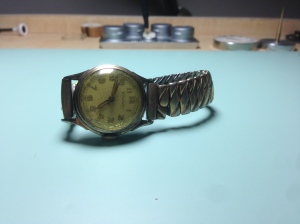The 70s was a formative decade worldwide and people have mixed feelings about parts of it (think Nixon, Disco, Thatcher, etc.) I have no opinion on these matters. I was not alive to pass judgment on the goings on and so I feel that I do not have the right (If I happen to restore a watch from the 80s though, all bets are off.) I do have to say that watch designs during this decade were pretty awesome. Prior to this time watches tended to be daintier in size and look. This decade saw the re-examination of components like the watchcase and the hands and turned them into prominent design elements.
This Bulova Jet Star from 1972 just screams 70s and I love it.
The general aesthetic of this watch is somewhere between “chunky” and space age. Most certainly a divergence from the common round and tank shaped watches from decades before, this odd shape almost looks like it belongs on Batman’s utility belt. Although it doesn’t look like it, the lug-to-lug measurement and the width (excluding the crown) are identical. The brushed finish helps to accentuate the unique design of the hands and dial as well as to soften the look of the metal. It also helps to provide a sharp line and angle contrast making this watch look rather sleek despite its size. All to often on these watches this delicate finish is polished away and the watch looks like its been stuck in a chunky rounded mirror.
Typically watches have simple utilitarian hands. They either glowed or they didn’t and some had little stylistic elements (Breguet hands, etc.) but they were mostly there to perform their function. This Jet Star takes them a step further and adds a touch I have only ever seen on two watches: this one and the famous Bulova Chronograph C. You will notice that arrows have been drawn on the rectangular hands. As simple as this is it adds an eye-catching feature to an otherwise typical watch of the time.
This piece has an automatic Bulova 11BSACB or an AS 2066 movement which like most Bulova and AS movements is well built and easily withstands the test of time. It has a quickset date and day function, which is a bit of a pain to reassemble, but on the wrist it’s a fantastically practical mechanism.
The color scheme of this watch is definitively patriotic, so whether or not you think America was great during the 70s, this watch has been and will be around to wear in a decade more appropriate for American Pride.

























